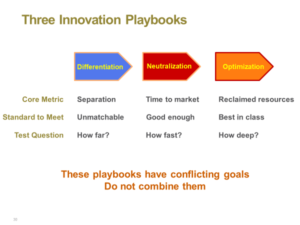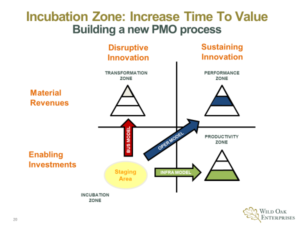
May 19, 2021
In the digital world,
the status quo no longer exists

How good is your organization at finding “a path to yes” rather than “a path to no?”
Disruptive change not only increases stress, uncertainty, and risk but it also enables individuals to retreat to what they know rather than explore what they don’t know. This is not only a death knell to successful new innovations, but it also undermines building a culture of creativity and collaboration.
Ed Catmull, long time head of Pixar Studios, put it this way, “Our natural tendency is to avoid or minimize risks. This instinct leads executives to choose to copy previous successes rather than try to create something brand new.”
The scope and speed of disruption from digital technologies is forcing companies to discover new ways to engage with their customers, employees, supply chain partners, and even their competitors. The five waves of digital disruption (social, mobile, cloud, data analytics, and connected devices) are completely altering how people connect, communicate, and discover information. These new tools affect how customers make decisions, which affect their entire customer journey, which ultimately affects their customer lifetime value.
To successfully compete in this new environment, you have to build an organizational culture that excels at finding a “path to yes” rather than a “path to no.”
The Covid-19 pandemic taught us that what seemed impossible was actually possible

Before the Covid-19 pandemic forced companies to relocate most, if not all, of their employees remotely, the conventional thinking was that such an exercise would take months or years. Many companies discovered they could do it in weeks.
This opened up a whole new decision-making framework that shifted the motivation from “can I do it?” to “look what I’ve done!”
Part of what made that result possible was the recognition that there was no time for long drawn out decision-making debates. While building consensus is sometimes helpful, the longer the process goes on, the easier it is for the nay-sayers to prevail.
To effectively compete as a digital enterprise requires new ways of discovering a path to yes.

Shantanu Narayen, CEO of Adobe, says that “if you can connect the dots between where you are today and where you think things are going, you’re probably not being aspirational enough. You have to plant this flag of ‘why can’t we do this?’ and give your employees freedom to amaze you with their ingenuity.”
In implementing this approach at Adobe, new product development teams are given “a license to be curious.” They can basically go off and explore any good idea that creates powerful features that large numbers of customer will happily pay for. Adobe has built an enterprise-wide culture that “takes a lot of pride in being a company that has to reinvent itself constantly.”
Many CEOs are not digitally native so they need to develop that understanding on the job. Fernando Gonzalez, CEO of Cemex, a global building materials company, did this by spending time with experts in technology-enabled business transformations; attending digital technology focused executive education programs and reading widely.
He used that knowledge to align his board and senior leadership team around a new business development effort called Cemex Go, the first one-stop customer platform in the industry which was launched in 2017. By 2019, Cemex Go had achieved 96% adoption among the company’s repeat customers and was delivering 45% of its annual sales.
Gary Scholten, Chief Digital & Information Officer at Principal Financial Group, organized visits for senior leadership teams to digitally native financial services firms to understand how they approached doing business. He also hosted internal digital hackathons and other digital technology information gathering activities. This enabled the company’s executive committee to evaluate potential digital offerings and projects from a strategic perspective. Through this effort, the committee “developed a portfolio of investments with an internal rate of return exceeding 20%, with two-thirds of the benefits coming from top-line growth.”
A framework and game plan for finding a Path to Yes

Regardless of whether it is the CEO, Chief Digital Officer, or Chief Innovation Officer who is driving the business innovation process, companies must approach things with a very different mindset and a different plan of attack.
In his book Escape Velocity – Free Your Company’s Future From The Pull Of The Past, my brother Geoffrey Moore, put forth a three-part innovation framework that is designed to significantly increase the ROI on innovation investments. At the core of this framework are three distinct innovation playbooks, as shown on the chart below, that require different management approaches to get the desired ROI.

Here are the key diagnostic questions that clarify the mandates and outcomes for the three different innovation playbooks:
Differentiation Innovations: Have we differentiated our offer enough to gain real competitive separation? Have we created a truly unmatchable offer?
Neutralization Innovations: Have we neutralized offers with enhanced features from our reference competitors in a timely manner? Have we gotten to “good enough” fast enough?
Optimization Innovations: Have we optimized our opportunities for gains in resource utilization and cost reduction? Have we reclaimed unproductive resources and redeployed them against differentiation or neutralization opportunities?
Building a new business innovation PMO
More recently I have been working with digital technology innovation teams using the 4 Zones Model framework shown below to prioritize and manage a portfolio of business innovation projects. The early results of this approach have been a significant increase in time to value and a more direct impact on new revenues, margins, and profits.

With this approach, the incubation zone is used as a staging area to prioritize all business innovation initiatives. Each initiative is first segmented using the following questions:
- Are they sustaining innovations or disruptive innovations?
- Are they enabling systems productivity and cost optimization?
- Are they increasing business unit operating performance and revenue growth?
- Are they enabling business model transformation?
In addition, instead of using resource capacity and budgeting constraints to make prioritization decisions, we deploy the following three questions:
- Should we do it? Does it align with and support critical business outcomes?
- Can we do it? Do we have the relevant skills, capabilities, and tools to achieve the desired outcome?
- Did we do it? Do we have the right metrics to measure the achieved outcome vs. the desired outcome?
Some best practices to help you win the business innovation wars
In working with different companies over the past several years to help them hone their business innovation skills, I have seen a series of best practices that increase the odds of winning the business innovation wars.
- You need to gain cross-enterprise alignment and support for a digital-first business growth strategy and implementation plan.
- The competitive landscape is changing so fast that anything less than an all-in approach will likely fail.
- You need to create a culture of continuous learning and experimentation and be willing to fail fast and learn fast.
- You need to excel at segmenting competing innovation options into three playbooks and manage each type differently to maximize their potential ROI.
- You need to be able to leverage data and analytics to identify and create entirely new customer services and experiences.
- You need to be able to construct and orchestrate business partner networks & ecosystems that leverage the competitive benefits of assets you don’t own and directly control.
- You need to have the resolve to sacrifice short term revenue and earnings in order to create sustainable long term competitive advantage.
The business environment is littered with examples of companies who could not catch the next wave of digital disruption. If you are a leader who has the vision, resolve, and commitment to find a path to yes, I’d welcome the opportunity to help you achieve that goal.
As always, I am interested in your comments, feedback and perspectives on the ideas put forth in this blog. Please e-mail them to me at here. And, if this content could be useful to someone you know please share it here:



